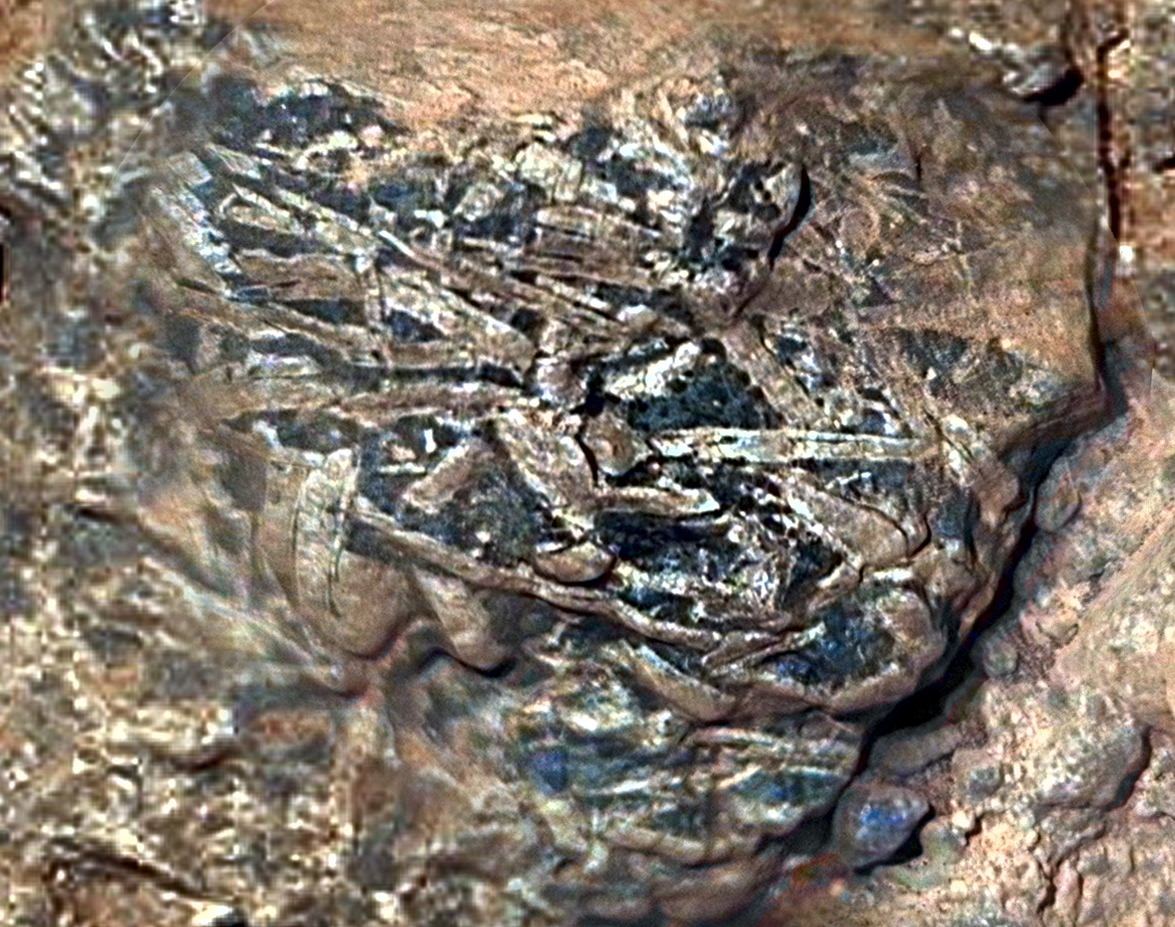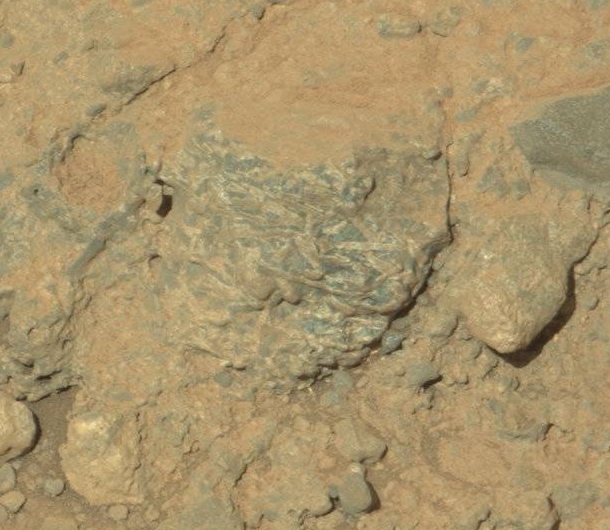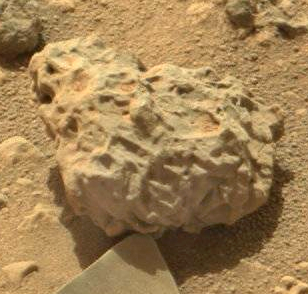It looks like you're using an Ad Blocker.
Please white-list or disable AboveTopSecret.com in your ad-blocking tool.
Thank you.
Some features of ATS will be disabled while you continue to use an ad-blocker.
7
share:
Here is a beautiful looking crystal found on mars with the Curiosity Rover. Im seeing a mixture of shapes that almost resemble aztec looking
hieroglyphs. Imagine it perfectly cut and polished.
Im sure we could farm these in the near future. This may help fund better space exploration research & development in some way.
Martian Rock "Harrison"

Im sure we could farm these in the near future. This may help fund better space exploration research & development in some way.
Harrison bears elongated, light-colored crystals in a darker matrix. Some of the crystals are about 0.4 inch (1 centimeter) in size. Figure A is a version of the image with a superimposed scale bar of 5 centimeters (about 2 inches).
Martian Rock "Harrison"

Oh, how pretty! It's "pattern", if you will, kind of reminds me of Lapis
Lazuli in a way with the straight lines. I bet if it was polished up, it would look somewhat like
Pietersite in color. I bet others who are more into gems would be able to come
up with better comparisons than me, though.
And yep, I'd buy this Harrison stone. A simple round pendant would be lovely, I bet.
If you'd read your own article link, you'd see the color correction in the photo shown is to align it with what it would look like in Earth-like light to make it easier for the geologists to scrutinize. Ergo, if you brought the rocks back here, yeah, they'd probably be more similar to the color corrected one than the Mars light one. The difference is literally in the light.
And yep, I'd buy this Harrison stone. A simple round pendant would be lovely, I bet.
1Providence1
reply to post by Ezappa
Are they really crystals?
www.theatlantic.com...
If you'd read your own article link, you'd see the color correction in the photo shown is to align it with what it would look like in Earth-like light to make it easier for the geologists to scrutinize. Ergo, if you brought the rocks back here, yeah, they'd probably be more similar to the color corrected one than the Mars light one. The difference is literally in the light.
reply to post by Ezappa
Unfortunately while it does look cool they are nothing that can't be found here on Earth.
www.minfind.com...
Im sure we could farm these in the near future. This may help fund better space exploration research & development in some way.
Unfortunately while it does look cool they are nothing that can't be found here on Earth.
Based on composition information gathered from an array of ChemCam laser shots on Harrison, the elongated crystals are likely feldspars, and the matrix is pyroxene-dominated. This mineral association is typical of basaltic igneous rocks. The texture provides compelling evidence for igneous rocks at Gale Crater, where Curiosity is on a traverse to reach the lower slopes of Mount Sharp near the center of the crater.
www.minfind.com...
reply to post by Nyiah
Pietersite Gems look like little worlds with oceans and land mass how awsome!
Pietersite Gems look like little worlds with oceans and land mass how awsome!
reply to post by Ezappa
It's a pretty rock, but, I'm more interested in Impact Diamonds, created from carbonaceous meteors and asteroids slamming into a planetary body.
There's a LOT of craters on the Moon ... hmmm.
Other than the conventional industrial uses for diamonds, as well as the aesthetic, there's also such things as using the stuff as substrate for processors that operate in the hundreds of GHz, as well as storage substrate and some several other super duper nifty Information related stuff.
What can someone DO with diamond processors, and diamond based computers?
I dunno, maybe with the substantially fantastic differences in raw dangling horsepower in the Hundreds of GHz, we might have actual practical, real Artificial Intelligence?
There's more to it than that, but, yeah, diamonds.
Diamonds good.
Impact diamonds that typically show greater density than your average diamond; even better.
It's a pretty rock, but, I'm more interested in Impact Diamonds, created from carbonaceous meteors and asteroids slamming into a planetary body.
There's a LOT of craters on the Moon ... hmmm.
Other than the conventional industrial uses for diamonds, as well as the aesthetic, there's also such things as using the stuff as substrate for processors that operate in the hundreds of GHz, as well as storage substrate and some several other super duper nifty Information related stuff.
What can someone DO with diamond processors, and diamond based computers?
I dunno, maybe with the substantially fantastic differences in raw dangling horsepower in the Hundreds of GHz, we might have actual practical, real Artificial Intelligence?
There's more to it than that, but, yeah, diamonds.
Diamonds good.
Impact diamonds that typically show greater density than your average diamond; even better.
reply to post by gortex
When I meant farm them I guess i did not explain right, sorry. What i meant was, We could build rovers just for mining them and somehow send them back to earth. Maybe the price they would fetch could cover the costs of the logistics.
When I meant farm them I guess i did not explain right, sorry. What i meant was, We could build rovers just for mining them and somehow send them back to earth. Maybe the price they would fetch could cover the costs of the logistics.
Nyiah
If you'd read your own article link, you'd see the color correction in the photo shown is to align it with what it would look like in Earth-like light to make it easier for the geologists to scrutinize. Ergo, if you brought the rocks back here, yeah, they'd probably be more similar to the color corrected one than the Mars light one. The difference is literally in the light.
IMO the question is still legit: are these crystals (exclusively)? Apparently, ChemCam was used together with MastCam100 images to present "microscopic details" (quote) and to check the basic consistency of the ribbons we see.
I suppose that using MAHLI for the microscopic details of these overlapping, not 100% straight but bent features would have been a complete waste of time?! Well, be it so ... but perhaps this could have been one of those things that, out of a zillion of featureless rocks, one might have investigated a bit closer using MAHLI, not?! Oh well, apparently there's nothing to see here, so let's move on ...
This is probably a common mineral, but the idea of a rare space based commodity as a standard for our earth based currency sounds interesting.
What rare minerals are available on Mars, or closer yet the moon, to help our earthly economy and finance space exploration?
Not trying to derail this thread, but the idea is worthy of a new thread IMO.
What rare minerals are available on Mars, or closer yet the moon, to help our earthly economy and finance space exploration?
Not trying to derail this thread, but the idea is worthy of a new thread IMO.
I collect meteorites, and have a small sample of LA 001, a Mars meteorite, recently classified as a basaltic shergottite.
Under a microscope , the crystal structure is just absolutely stunning.
I will try and get a photo from the scope, just have to get all that stuff out and hook it up.
I will post it here as soon as I get to it.
Under a microscope , the crystal structure is just absolutely stunning.
I will try and get a photo from the scope, just have to get all that stuff out and hook it up.
I will post it here as soon as I get to it.
edit on 9-2-2014 by charlyv because: spelling , where caught
well we have two types of gem here on earth that are either from outer space or are created by something from outer space hitting earth. moisonite is
extra-terrestrial if i recall correctly. and peridot sometimes forms in the ejecta of large meteor impacts. peridot has been detected on the moon.
just checked my facts and there are more gems that have ended up on earth from outer space too.
but extraterrestrial gems would be extremely valuable when there is clear authentication. a jupiter atmospheric diamond would be priceless even though jupiter diamonds might be any size up to the size of jupiter's core. if you could send something into jupiter's atmosphere and have it survive you might be able to harvest diamonds from micron sized on up to massive hailstone sized. it is theorized the immense pressure of jupiters atmosphere acting on carbon containing gases and compounds should create a rain of diamonds, graphene and other novel things like that. A peridot from the moon would not be semiprecious. it would top terrestrial diamonds in value.
the picture looks like several types of earth gem including iolite.
but extraterrestrial gems would be extremely valuable when there is clear authentication. a jupiter atmospheric diamond would be priceless even though jupiter diamonds might be any size up to the size of jupiter's core. if you could send something into jupiter's atmosphere and have it survive you might be able to harvest diamonds from micron sized on up to massive hailstone sized. it is theorized the immense pressure of jupiters atmosphere acting on carbon containing gases and compounds should create a rain of diamonds, graphene and other novel things like that. A peridot from the moon would not be semiprecious. it would top terrestrial diamonds in value.
the picture looks like several types of earth gem including iolite.
According to the article you linked, it's just feldspar. We have plenty of that on Earth.
I wish they examined it with MAHLI, it provides much better colours, as well as great close-up resolution.
Here's the raw Mastcam image: mars.jpl.nasa.gov...

Distinctly unimpressive, if you ask me.
You're right in a way that, were these minerals excavated and brough to Earth, they would be quite expensive, due to the fact where they came from, not due to their mineralogical value.
[Edit] These features are most likely feldspar laths. www.anr.state.vt.us...
These are typically plagioclase feldspar phenocrysts in a rock that formed from a slowly cooled magma. - Source
I wish they examined it with MAHLI, it provides much better colours, as well as great close-up resolution.
Here's the raw Mastcam image: mars.jpl.nasa.gov...

Distinctly unimpressive, if you ask me.
You're right in a way that, were these minerals excavated and brough to Earth, they would be quite expensive, due to the fact where they came from, not due to their mineralogical value.
[Edit] These features are most likely feldspar laths. www.anr.state.vt.us...
These are typically plagioclase feldspar phenocrysts in a rock that formed from a slowly cooled magma. - Source
edit on 9-2-2014 by wildespace because:
(no reason given)
don't dismiss feldspar gemstones as unimpressive. moonstone and labradorite are feldspar gemstones.
if you found a clear labrodolite with that blue color in the first picture it would be most impressive. there are clear ones, silvery ones, and orange ones (sunstones.)
oops! there are blue ones here too. spectacular looking gem.
www.google.com... =862
if you found a clear labrodolite with that blue color in the first picture it would be most impressive. there are clear ones, silvery ones, and orange ones (sunstones.)
oops! there are blue ones here too. spectacular looking gem.
www.google.com... =862
edit on 9-2-2014 by stormbringer1701 because: adding info
reply to post by MichiganSwampBuck
standard for our earth based currency sounds interesting.
Nah wont work... JPMorgan or Goldman sachs will corner the market warehouse them, short them, same old Ponzi scheme run by the same crooks
reply to post by Ezappa
Looks more like fossilised reed leaves to me, but i'm not a geologist or a botanist.
Looks more like fossilised reed leaves to me, but i'm not a geologist or a botanist.
Not all precious stones are shiny. Some are super functional or unusual features, like these.
I wouldn't trade these Rocks for any others
I wouldn't trade these Rocks for any others
edit on 18-9-2017 by SpectateSwamp because: video not working
edit on
18-9-2017 by SpectateSwamp because: video not working
originally posted by: jeep3r
[...] but perhaps this could have been one of those things that, out of a zillion of featureless rocks, one might have investigated a bit closer using MAHLI, not?! Oh well, apparently there's nothing to see here, so let's move on ...
My original thought when that rock first showed up is that they were fossilized reeds or leaves of some kind. But, like you say, Curiosity was in a huge rush to get to that boring hill, so they didn't bother to check. OH WELL NEXT TIME!
Kind of reminded me of this one:

edit on 18-9-2017 by Blue Shift because: (no reason given)
new topics
-
BIDEN Admin Begins Planning For January 2025 Transition to a New President - Today is 4.26.2024.
2024 Elections: 2 hours ago -
Big Storms
Fragile Earth: 3 hours ago -
Where should Trump hold his next rally
2024 Elections: 6 hours ago -
Shocking Number of Voters are Open to Committing Election Fraud
US Political Madness: 7 hours ago -
Gov Kristi Noem Shot and Killed "Less Than Worthless Dog" and a 'Smelly Goat
2024 Elections: 7 hours ago -
Falkville Robot-Man
Aliens and UFOs: 8 hours ago -
James O’Keefe: I have evidence that exposes the CIA, and it’s on camera.
Whistle Blowers and Leaked Documents: 8 hours ago -
Australian PM says the quiet part out loud - "free speech is a threat to democratic dicourse"...?!
New World Order: 9 hours ago -
Ireland VS Globalists
Social Issues and Civil Unrest: 10 hours ago -
Biden "Happy To Debate Trump"
2024 Elections: 10 hours ago
top topics
-
James O’Keefe: I have evidence that exposes the CIA, and it’s on camera.
Whistle Blowers and Leaked Documents: 8 hours ago, 17 flags -
Australian PM says the quiet part out loud - "free speech is a threat to democratic dicourse"...?!
New World Order: 9 hours ago, 15 flags -
Blast from the past: ATS Review Podcast, 2006: With All Three Amigos
Member PODcasts: 12 hours ago, 13 flags -
Biden "Happy To Debate Trump"
2024 Elections: 10 hours ago, 12 flags -
Ireland VS Globalists
Social Issues and Civil Unrest: 10 hours ago, 9 flags -
Mike Pinder The Moody Blues R.I.P.
Music: 12 hours ago, 8 flags -
What is the white pill?
Philosophy and Metaphysics: 12 hours ago, 6 flags -
Shocking Number of Voters are Open to Committing Election Fraud
US Political Madness: 7 hours ago, 6 flags -
RAAF airbase in Roswell, New Mexico is on fire
Aliens and UFOs: 10 hours ago, 5 flags -
Where should Trump hold his next rally
2024 Elections: 6 hours ago, 5 flags
active topics
-
RAAF airbase in Roswell, New Mexico is on fire
Aliens and UFOs • 11 • : Ophiuchus1 -
SETI chief says US has no evidence for alien technology. 'And we never have'
Aliens and UFOs • 79 • : SchrodingersRat -
Gold and silver prices....woo hoo
History • 88 • : SchrodingersRat -
University of Texas Instantly Shuts Down Anti Israel Protests
Education and Media • 314 • : Schmoe3755 -
BIDEN Admin Begins Planning For January 2025 Transition to a New President - Today is 4.26.2024.
2024 Elections • 10 • : BingoMcGoof -
President BIDEN's FBI Raided Donald Trump's Florida Home for OBAMA-NORTH KOREA Documents.
Political Conspiracies • 39 • : AwakeNotWoke -
Gov Kristi Noem Shot and Killed "Less Than Worthless Dog" and a 'Smelly Goat
2024 Elections • 55 • : AwakeNotWoke -
Big Storms
Fragile Earth • 13 • : AwakeNotWoke -
SHORT STORY WRITERS CONTEST -- April 2024 -- TIME -- TIME2024
Short Stories • 26 • : Encia22 -
Biden "Happy To Debate Trump"
2024 Elections • 50 • : Lumenari
7
